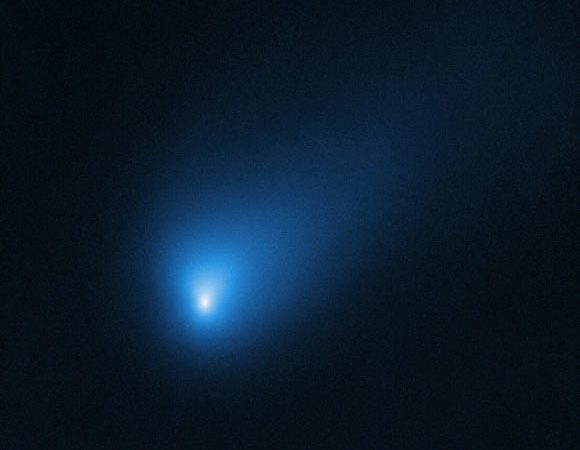Astronomers have detected the signature of vaporized water in the coma of the interstellar comet 2I/Borisov, also known as C/2019 Q4.
Source: Sci News
Comets are thought to be repositories of primitive, unaltered matter left over from the birth of the Solar System.
This makes studies of cometary volatile materials powerful for understanding the physical and chemical processes occurring during planet formation.
“The discovery of the interstellar comet 2I/Borisov provides an opportunity to sample the volatile composition of a comet that is unambiguously from outside our own Solar System, providing constraints on the physics and chemistry of other protostellar disks,” said Dr. Adam McKay of NASA’s Goddard Space Flight Center and American University and colleagues.
“As water (H2O) is the dominant volatile in most Solar System comets, measuring the H2O production in 2I/Borisov is key for interpretation of all other observations of this comet, including other volatiles.”
The astronomers analyzed spectra of 2I/Borisov obtained by the ARCES instrument, a high spectral resolution spectrograph mounted on the 3.5-m Astrophysical Research Consortium Telescope at Apache Point Observatory.
They detected the presence of water via the [O I] 6300 Å line emission.
“We determined an H2O production rate of 6.3*1026 mol/s,” the researchers explained, “which when compared to cyanide (CN) gas measurements suggest Borisov is either enhanced or typical in CN compared to the average value for Solar System comets, though the enhanced numbers are still within the range of observed values.”
“Diatomic carbon (C2), while likely depleted compared to CN, is either typical or depleted when compared to H2O.”
“Using a simple sublimation model, we found an H2O active area of 1.7 km2,” they added.
“More measurements are needed as 2I/Borisov approaches perihelion to fully understand its composition and activity.”
The findings will be published in the Astrophysical Journal Letters.
Source: Sci News
2 comments
































2 Comments
David Sims
November 5, 2019, 12:58 pmJPL updated the elements for 2I/Borisov today (6 November 2019) with a solution dated 4 November 2019. The Keps are shown below, and following that are my calculated data for perihelion and for closest approach to Earth.
ORBITAL ELEMENTS
a = −0.8514635301968232 AU
e = 3.356609495046351
i = 44.05127769660942°
Ω = 308.1483704909913°
ω = 209.1246690138472°
T = 2458826.0556761008 JD
PERIHELION
time: 13h 20m 10s on 8 Dec 2019 UTC (JD 2458826.055676)
Borisov mean anomaly: 0°
Borisov eccentric anomaly: 0°
Borisov true anomaly: 0°
HEC x = −1.63473765 AU
HEC y = +0.944902972 AU
HEC z = −0.679045259 AU
HEC Vx = −8474.86239 m/s
HEC Vy = −33818.6616 m/s
HEC Vz = −26656.8051 m/s
HEC distance: 2.00656704 AU
HEC longitude: 149.971441°
HEC latitude: −19.7801205°
speed relative to the sun: 43887.4746 m/s = 0.000146392858 c
obliquity of the ecliptic: 23.4366991°
Geocentric distance: 1.99432758 AU = 16.5863167 light minutes
Geocentric right ascension: 11h 28m 21.31s
Geocentric declination: −18° 19′ 37.3″
That’s in the area of sky between γ Crateris and λ Crateris.
Angle Sun-Earth-Borisov: 76.4381024°
Angle Earth-Sun-Borisov: 75.0580449°
CLOSEST APPROACH TO EARTH
REPLYtime: 3h 47m 57s on 28 December 2019 UTC (JD 2458845.65830)
Borisov mean anomaly: 24.5905996°
Borisov eccentric anomaly: 10.3543301°
Borisov true anomaly: 13.9705528°
HEC x = −1.71910697 AU
HEC y = +0.556340062 AU
HEC z = −0.975428365 AU
HEC Vx = −6435.95186 m/s
HEC Vy = −34734.3040 m/s
HEC Vz = −25652.7829 m/s
HEC distance: 2.05336396 AU
HEC longitude: 162.067301°
HEC latitude: −28.3619021°
speed relative to the sun: 43657.2860 m/s = 0.000145625031 c
obliquity of the ecliptic: 23.4366921°
Geocentric distance: 1.93693199 AU = 16.1089722 light minutes
Geocentric right ascension: 11h 59m 53.18s
Geocentric declination: −33° 16′ 33.4″
That’s about 1.5° east of β Hydrae.
Angle Sun-Earth-Borisov: 82.421405°
Angle Earth-Sun-Borisov: 69.2373806°
David Sims
November 5, 2019, 1:12 pmObserver data for Comet 2I/Borisov
EPHEMERIS for December 2019
All positions for 9pm Eastern Standard Time
(date) (right ascension) (declination) (geoc. distance)
1 Dec 11h 17m 27.64s −13° 23′ 23.0" 2.03972323
6 Dec 11h 25m 53.62s −17° 11′ 44.7" 2.00348449
11 Dec 11h 34m 12.49s −21° 02′ 46.2" 1.9751970
Full moon on 12 Dec.
16 Dec 11h 42m 23.14s −24° 54′ 03.5" 1.95483033
21 Dec 11h 50m 24.16s −28° 43′ 27.2" 1.94222409
26 Dec 11h 58m 13.87s −32° 28′ 49.5" 1.93709440
31 Dec 12h 05m 50.16s −36° 08′ 10.7" 1.93904856
Expected brightest apparent magnitude: +15.3 (in mid-December 2019)
REPLYBorisov’s hyperbolic excess speed: 32278.2742 m/s